Organisational Behaviour Report - Leadership Management Module
VerifiedAdded on 2020/12/09
|18
|4432
|271
Report
AI Summary
This report provides an analysis of organisational behaviour, focusing on the case of A David & Co. The report explores the influence of organisational culture, politics, and power dynamics on individual and team behaviour and performance. It examines Handy's Model of culture and various types of power, including coercive, reward, legitimate, expert, and referent power. The report also delves into content and process theories of motivation, specifically Maslow's Hierarchy of Needs and Herzberg's Two-Factor Theory, along with their application within the company. The analysis covers both positive and negative aspects of politics within the organisation, structural and decisional factors, and their impact on employee motivation and organisational goal achievement. The report also discusses motivational techniques, including recognition, achievement, and responsibility, and hygiene factors such as company policies, pay, and interpersonal relationships. The report concludes with an overview of effective and ineffective team dynamics within the company. The document is contributed by a student and available on Desklib, a platform providing AI-based study tools.
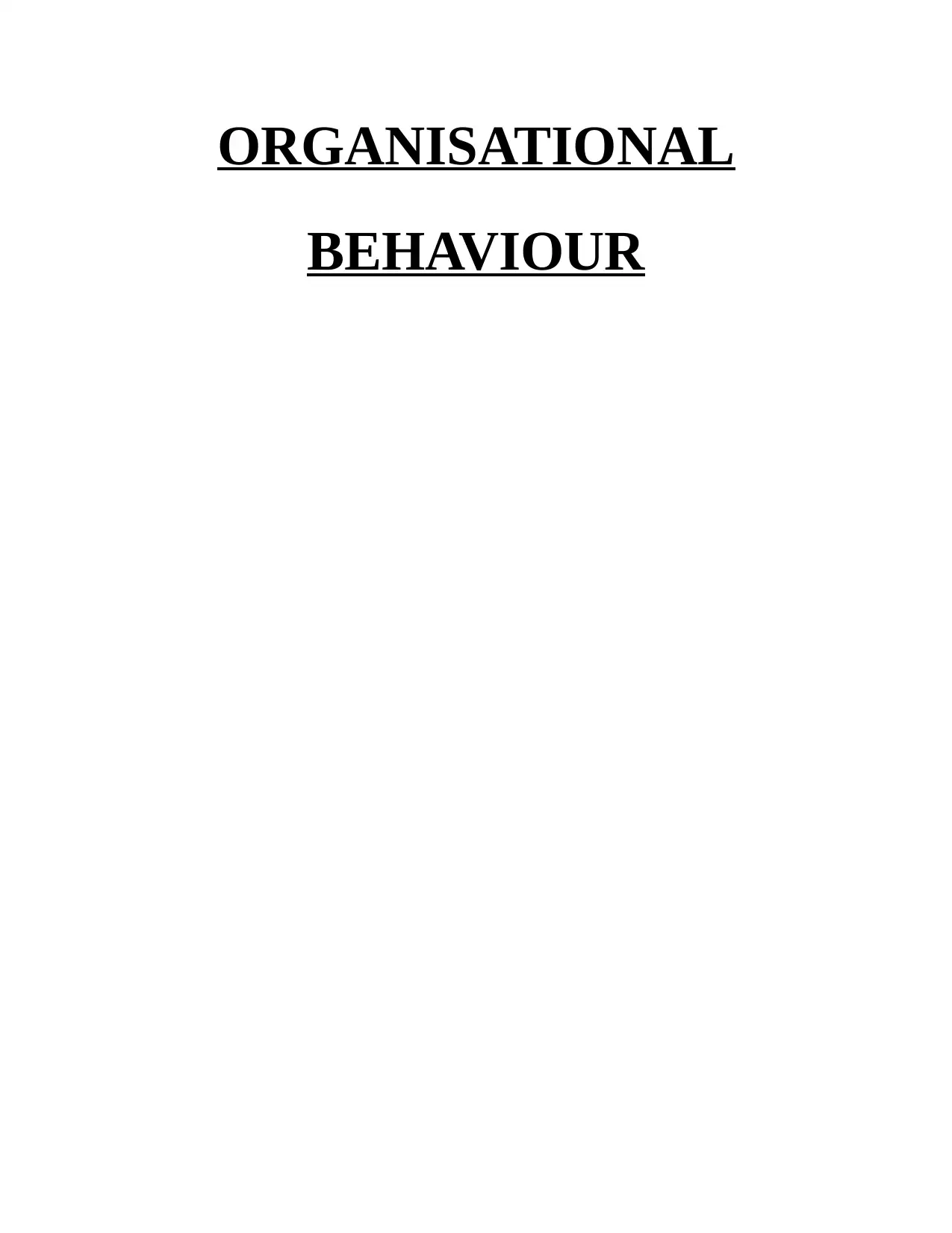
ORGANISATIONAL
BEHAVIOUR
BEHAVIOUR
Paraphrase This Document
Need a fresh take? Get an instant paraphrase of this document with our AI Paraphraser
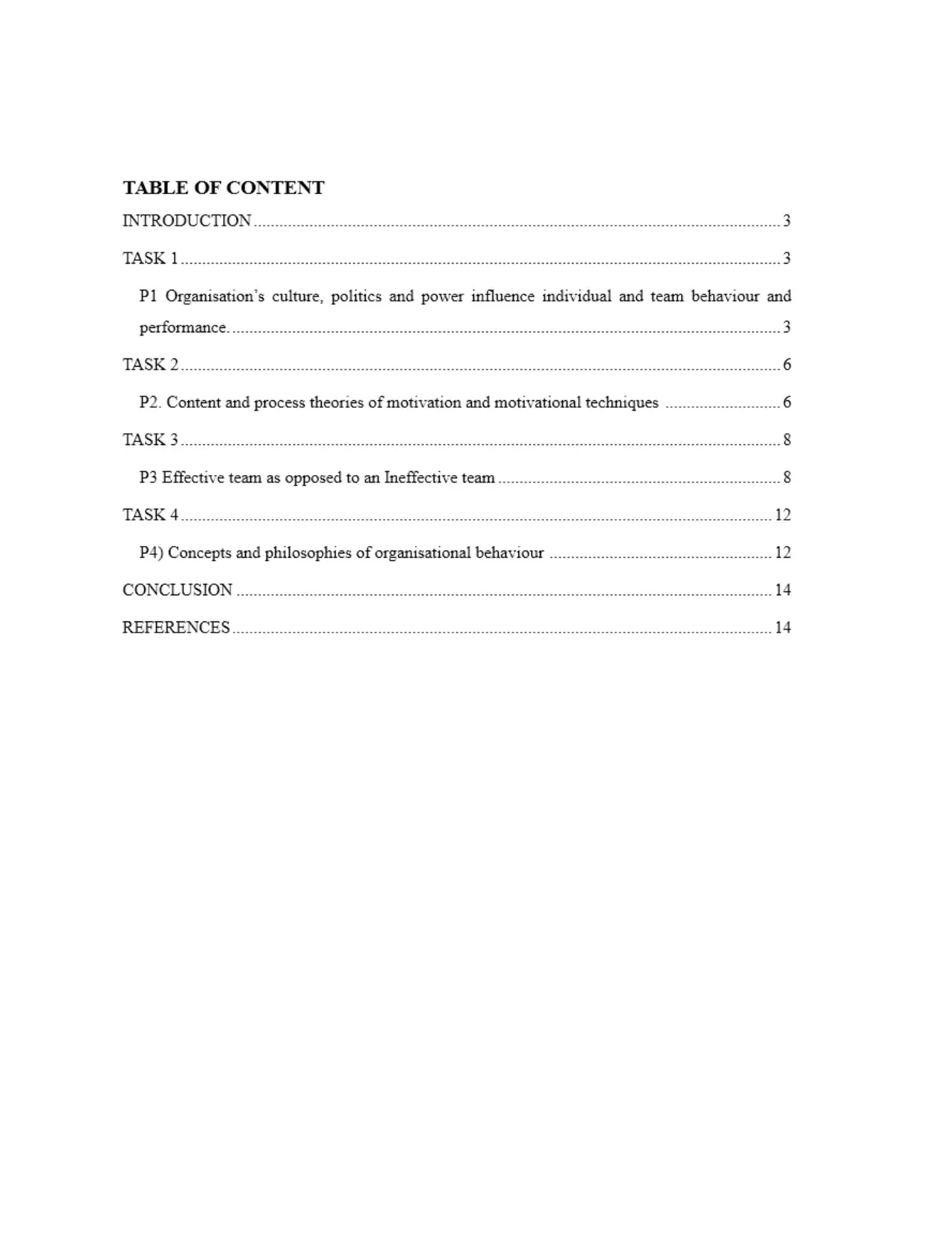
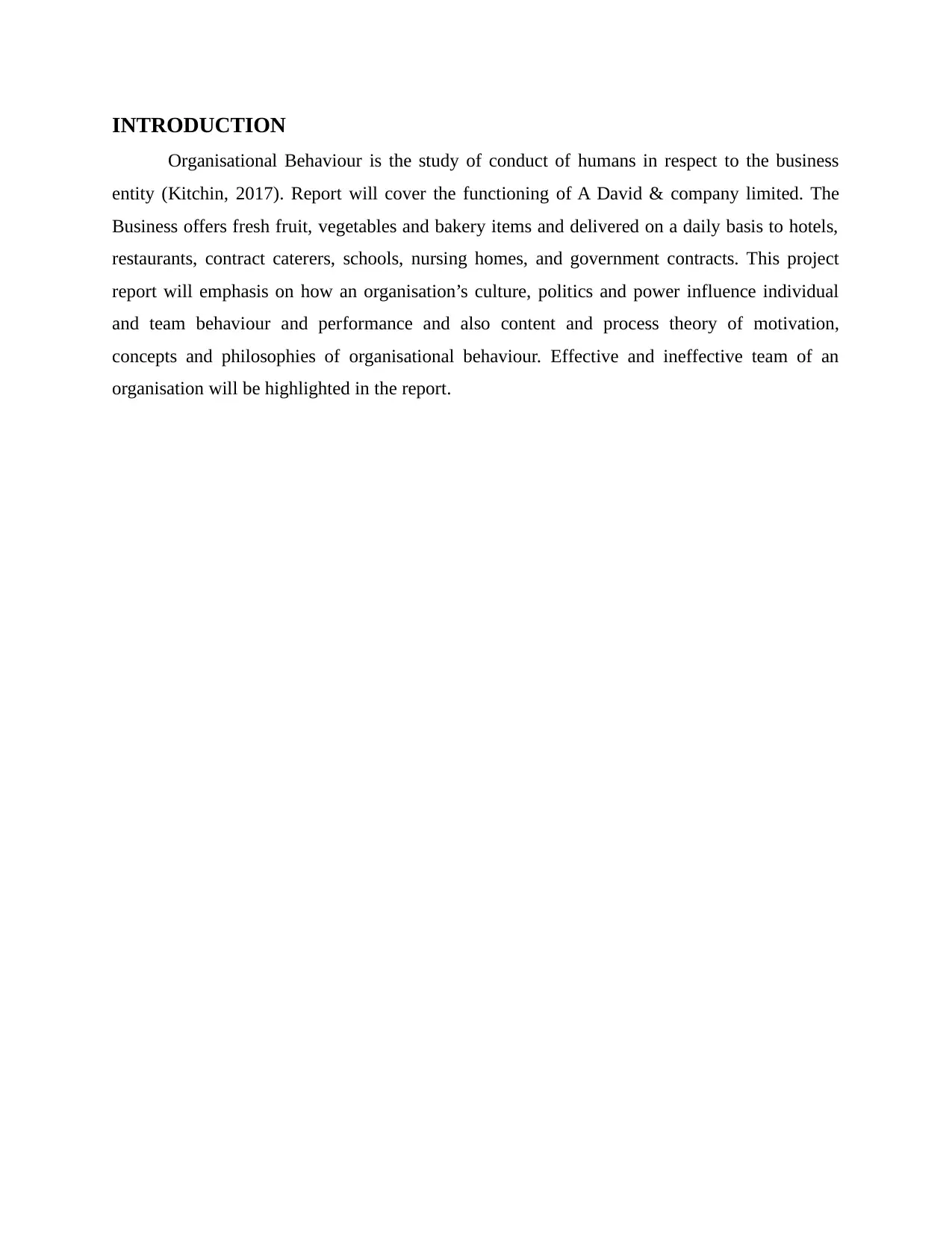
INTRODUCTION
Organisational Behaviour is the study of conduct of humans in respect to the business
entity (Kitchin, 2017). Report will cover the functioning of A David & company limited. The
Business offers fresh fruit, vegetables and bakery items and delivered on a daily basis to hotels,
restaurants, contract caterers, schools, nursing homes, and government contracts. This project
report will emphasis on how an organisation’s culture, politics and power influence individual
and team behaviour and performance and also content and process theory of motivation,
concepts and philosophies of organisational behaviour. Effective and ineffective team of an
organisation will be highlighted in the report.
Organisational Behaviour is the study of conduct of humans in respect to the business
entity (Kitchin, 2017). Report will cover the functioning of A David & company limited. The
Business offers fresh fruit, vegetables and bakery items and delivered on a daily basis to hotels,
restaurants, contract caterers, schools, nursing homes, and government contracts. This project
report will emphasis on how an organisation’s culture, politics and power influence individual
and team behaviour and performance and also content and process theory of motivation,
concepts and philosophies of organisational behaviour. Effective and ineffective team of an
organisation will be highlighted in the report.
⊘ This is a preview!⊘
Do you want full access?
Subscribe today to unlock all pages.

Trusted by 1+ million students worldwide
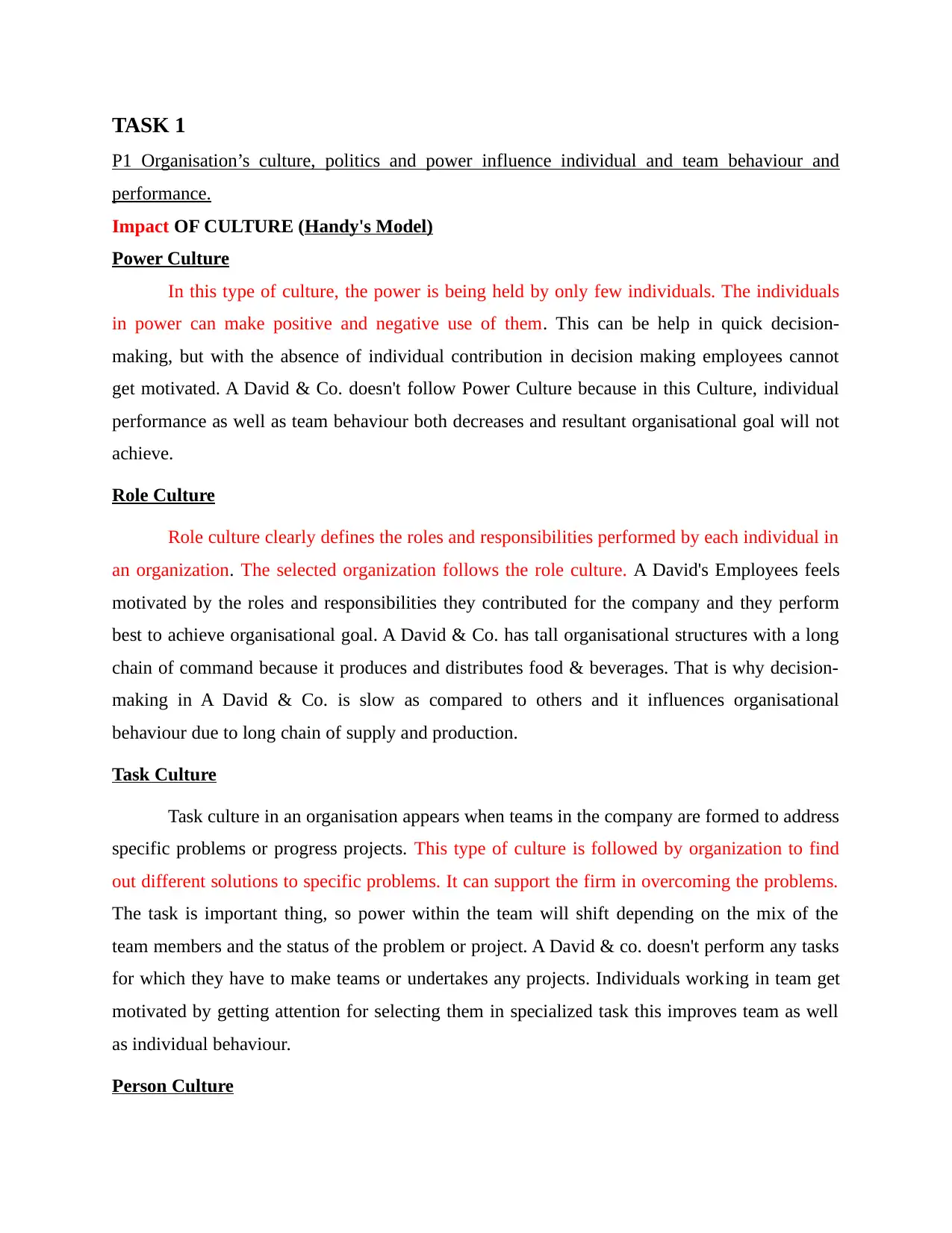
TASK 1
P1 Organisation’s culture, politics and power influence individual and team behaviour and
performance.
Impact OF CULTURE (Handy's Model)
Power Culture
In this type of culture, the power is being held by only few individuals. The individuals
in power can make positive and negative use of them. This can be help in quick decision-
making, but with the absence of individual contribution in decision making employees cannot
get motivated. A David & Co. doesn't follow Power Culture because in this Culture, individual
performance as well as team behaviour both decreases and resultant organisational goal will not
achieve.
Role Culture
Role culture clearly defines the roles and responsibilities performed by each individual in
an organization. The selected organization follows the role culture. A David's Employees feels
motivated by the roles and responsibilities they contributed for the company and they perform
best to achieve organisational goal. A David & Co. has tall organisational structures with a long
chain of command because it produces and distributes food & beverages. That is why decision-
making in A David & Co. is slow as compared to others and it influences organisational
behaviour due to long chain of supply and production.
Task Culture
Task culture in an organisation appears when teams in the company are formed to address
specific problems or progress projects. This type of culture is followed by organization to find
out different solutions to specific problems. It can support the firm in overcoming the problems.
The task is important thing, so power within the team will shift depending on the mix of the
team members and the status of the problem or project. A David & co. doesn't perform any tasks
for which they have to make teams or undertakes any projects. Individuals working in team get
motivated by getting attention for selecting them in specialized task this improves team as well
as individual behaviour.
Person Culture
P1 Organisation’s culture, politics and power influence individual and team behaviour and
performance.
Impact OF CULTURE (Handy's Model)
Power Culture
In this type of culture, the power is being held by only few individuals. The individuals
in power can make positive and negative use of them. This can be help in quick decision-
making, but with the absence of individual contribution in decision making employees cannot
get motivated. A David & Co. doesn't follow Power Culture because in this Culture, individual
performance as well as team behaviour both decreases and resultant organisational goal will not
achieve.
Role Culture
Role culture clearly defines the roles and responsibilities performed by each individual in
an organization. The selected organization follows the role culture. A David's Employees feels
motivated by the roles and responsibilities they contributed for the company and they perform
best to achieve organisational goal. A David & Co. has tall organisational structures with a long
chain of command because it produces and distributes food & beverages. That is why decision-
making in A David & Co. is slow as compared to others and it influences organisational
behaviour due to long chain of supply and production.
Task Culture
Task culture in an organisation appears when teams in the company are formed to address
specific problems or progress projects. This type of culture is followed by organization to find
out different solutions to specific problems. It can support the firm in overcoming the problems.
The task is important thing, so power within the team will shift depending on the mix of the
team members and the status of the problem or project. A David & co. doesn't perform any tasks
for which they have to make teams or undertakes any projects. Individuals working in team get
motivated by getting attention for selecting them in specialized task this improves team as well
as individual behaviour.
Person Culture
Paraphrase This Document
Need a fresh take? Get an instant paraphrase of this document with our AI Paraphraser
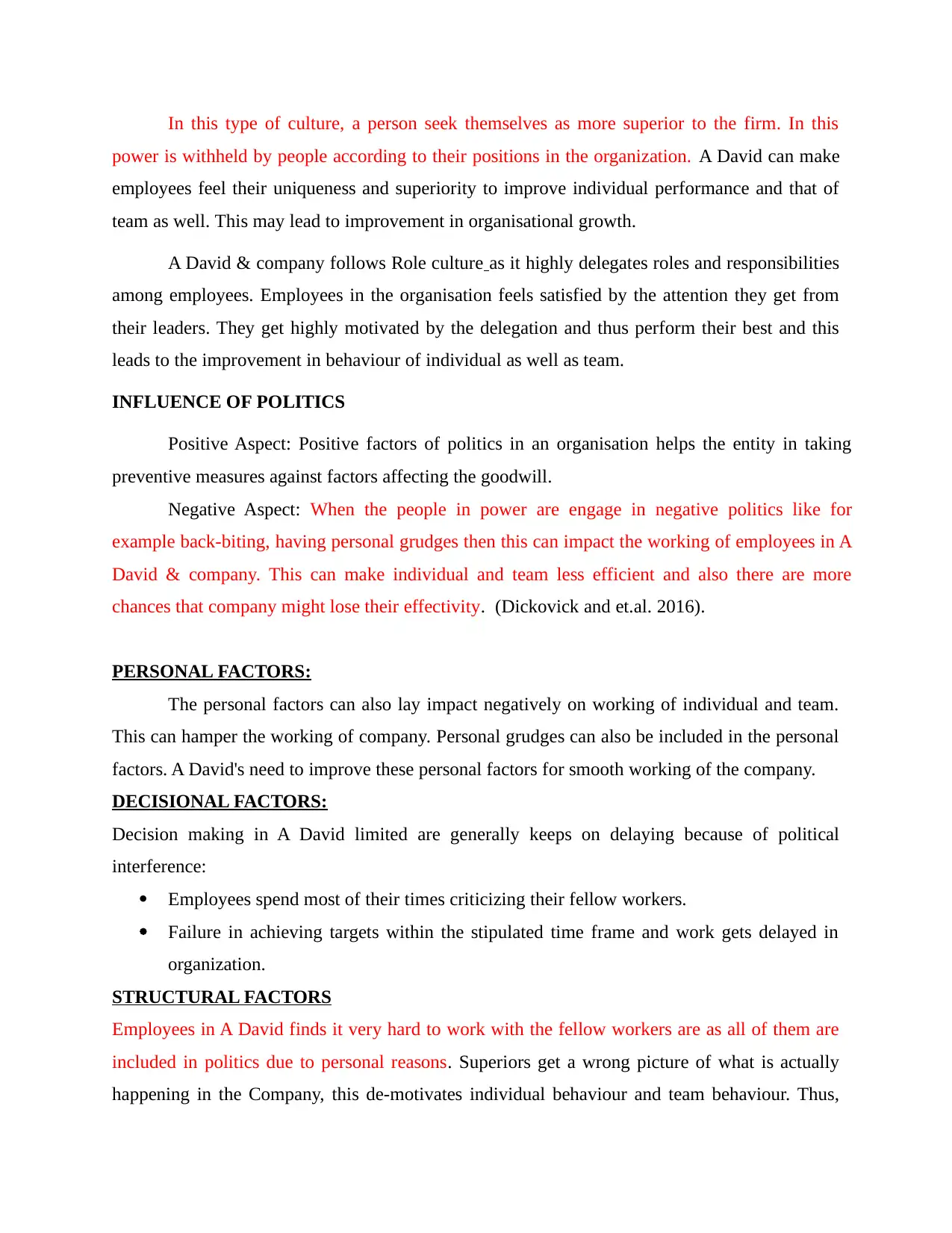
In this type of culture, a person seek themselves as more superior to the firm. In this
power is withheld by people according to their positions in the organization. A David can make
employees feel their uniqueness and superiority to improve individual performance and that of
team as well. This may lead to improvement in organisational growth.
A David & company follows Role culture as it highly delegates roles and responsibilities
among employees. Employees in the organisation feels satisfied by the attention they get from
their leaders. They get highly motivated by the delegation and thus perform their best and this
leads to the improvement in behaviour of individual as well as team.
INFLUENCE OF POLITICS
Positive Aspect: Positive factors of politics in an organisation helps the entity in taking
preventive measures against factors affecting the goodwill.
Negative Aspect: When the people in power are engage in negative politics like for
example back-biting, having personal grudges then this can impact the working of employees in A
David & company. This can make individual and team less efficient and also there are more
chances that company might lose their effectivity. (Dickovick and et.al. 2016).
PERSONAL FACTORS:
The personal factors can also lay impact negatively on working of individual and team.
This can hamper the working of company. Personal grudges can also be included in the personal
factors. A David's need to improve these personal factors for smooth working of the company.
DECISIONAL FACTORS:
Decision making in A David limited are generally keeps on delaying because of political
interference:
Employees spend most of their times criticizing their fellow workers.
Failure in achieving targets within the stipulated time frame and work gets delayed in
organization.
STRUCTURAL FACTORS
Employees in A David finds it very hard to work with the fellow workers are as all of them are
included in politics due to personal reasons. Superiors get a wrong picture of what is actually
happening in the Company, this de-motivates individual behaviour and team behaviour. Thus,
power is withheld by people according to their positions in the organization. A David can make
employees feel their uniqueness and superiority to improve individual performance and that of
team as well. This may lead to improvement in organisational growth.
A David & company follows Role culture as it highly delegates roles and responsibilities
among employees. Employees in the organisation feels satisfied by the attention they get from
their leaders. They get highly motivated by the delegation and thus perform their best and this
leads to the improvement in behaviour of individual as well as team.
INFLUENCE OF POLITICS
Positive Aspect: Positive factors of politics in an organisation helps the entity in taking
preventive measures against factors affecting the goodwill.
Negative Aspect: When the people in power are engage in negative politics like for
example back-biting, having personal grudges then this can impact the working of employees in A
David & company. This can make individual and team less efficient and also there are more
chances that company might lose their effectivity. (Dickovick and et.al. 2016).
PERSONAL FACTORS:
The personal factors can also lay impact negatively on working of individual and team.
This can hamper the working of company. Personal grudges can also be included in the personal
factors. A David's need to improve these personal factors for smooth working of the company.
DECISIONAL FACTORS:
Decision making in A David limited are generally keeps on delaying because of political
interference:
Employees spend most of their times criticizing their fellow workers.
Failure in achieving targets within the stipulated time frame and work gets delayed in
organization.
STRUCTURAL FACTORS
Employees in A David finds it very hard to work with the fellow workers are as all of them are
included in politics due to personal reasons. Superiors get a wrong picture of what is actually
happening in the Company, this de-motivates individual behaviour and team behaviour. Thus,
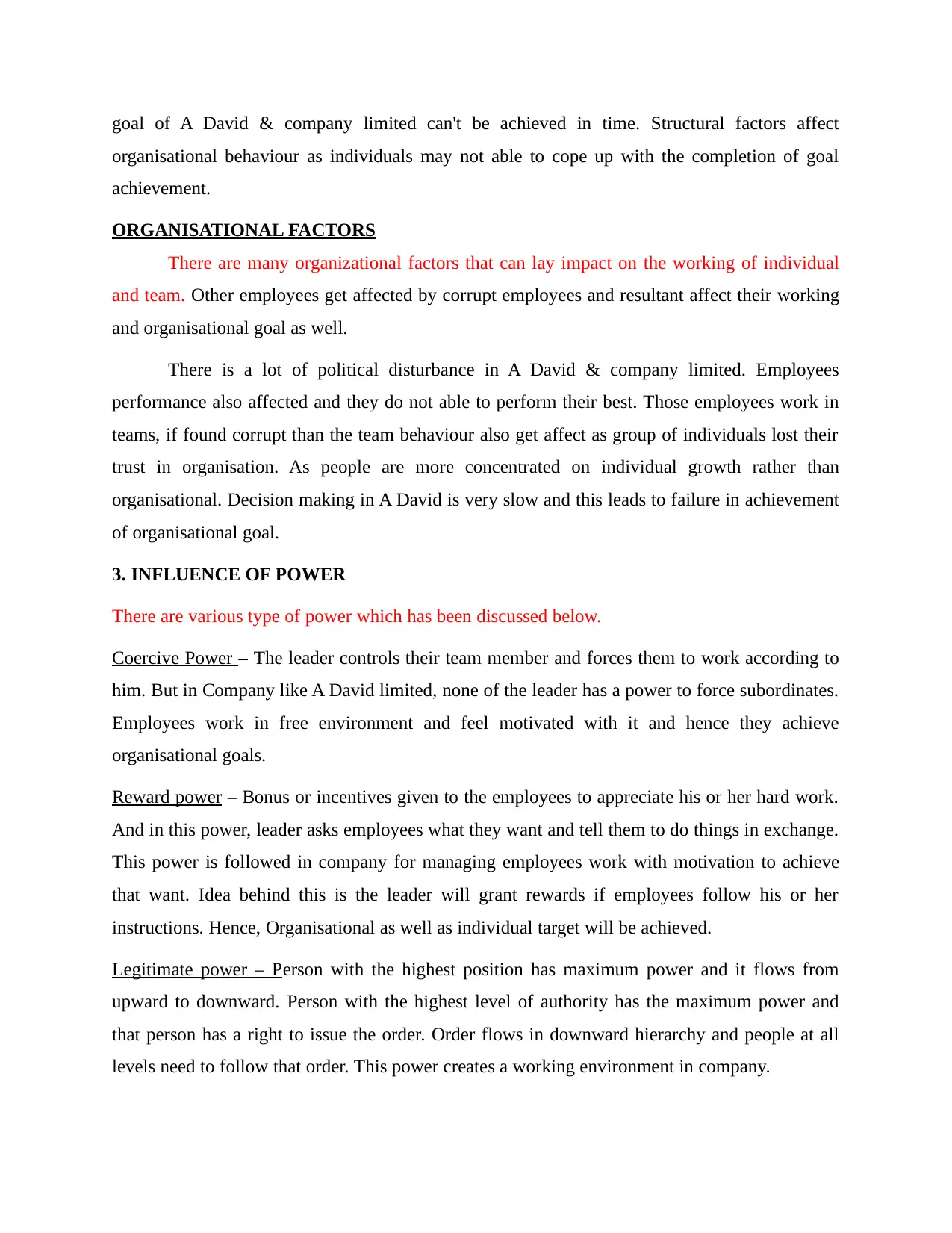
goal of A David & company limited can't be achieved in time. Structural factors affect
organisational behaviour as individuals may not able to cope up with the completion of goal
achievement.
ORGANISATIONAL FACTORS
There are many organizational factors that can lay impact on the working of individual
and team. Other employees get affected by corrupt employees and resultant affect their working
and organisational goal as well.
There is a lot of political disturbance in A David & company limited. Employees
performance also affected and they do not able to perform their best. Those employees work in
teams, if found corrupt than the team behaviour also get affect as group of individuals lost their
trust in organisation. As people are more concentrated on individual growth rather than
organisational. Decision making in A David is very slow and this leads to failure in achievement
of organisational goal.
3. INFLUENCE OF POWER
There are various type of power which has been discussed below.
Coercive Power – The leader controls their team member and forces them to work according to
him. But in Company like A David limited, none of the leader has a power to force subordinates.
Employees work in free environment and feel motivated with it and hence they achieve
organisational goals.
Reward power – Bonus or incentives given to the employees to appreciate his or her hard work.
And in this power, leader asks employees what they want and tell them to do things in exchange.
This power is followed in company for managing employees work with motivation to achieve
that want. Idea behind this is the leader will grant rewards if employees follow his or her
instructions. Hence, Organisational as well as individual target will be achieved.
Legitimate power – Person with the highest position has maximum power and it flows from
upward to downward. Person with the highest level of authority has the maximum power and
that person has a right to issue the order. Order flows in downward hierarchy and people at all
levels need to follow that order. This power creates a working environment in company.
organisational behaviour as individuals may not able to cope up with the completion of goal
achievement.
ORGANISATIONAL FACTORS
There are many organizational factors that can lay impact on the working of individual
and team. Other employees get affected by corrupt employees and resultant affect their working
and organisational goal as well.
There is a lot of political disturbance in A David & company limited. Employees
performance also affected and they do not able to perform their best. Those employees work in
teams, if found corrupt than the team behaviour also get affect as group of individuals lost their
trust in organisation. As people are more concentrated on individual growth rather than
organisational. Decision making in A David is very slow and this leads to failure in achievement
of organisational goal.
3. INFLUENCE OF POWER
There are various type of power which has been discussed below.
Coercive Power – The leader controls their team member and forces them to work according to
him. But in Company like A David limited, none of the leader has a power to force subordinates.
Employees work in free environment and feel motivated with it and hence they achieve
organisational goals.
Reward power – Bonus or incentives given to the employees to appreciate his or her hard work.
And in this power, leader asks employees what they want and tell them to do things in exchange.
This power is followed in company for managing employees work with motivation to achieve
that want. Idea behind this is the leader will grant rewards if employees follow his or her
instructions. Hence, Organisational as well as individual target will be achieved.
Legitimate power – Person with the highest position has maximum power and it flows from
upward to downward. Person with the highest level of authority has the maximum power and
that person has a right to issue the order. Order flows in downward hierarchy and people at all
levels need to follow that order. This power creates a working environment in company.
⊘ This is a preview!⊘
Do you want full access?
Subscribe today to unlock all pages.

Trusted by 1+ million students worldwide
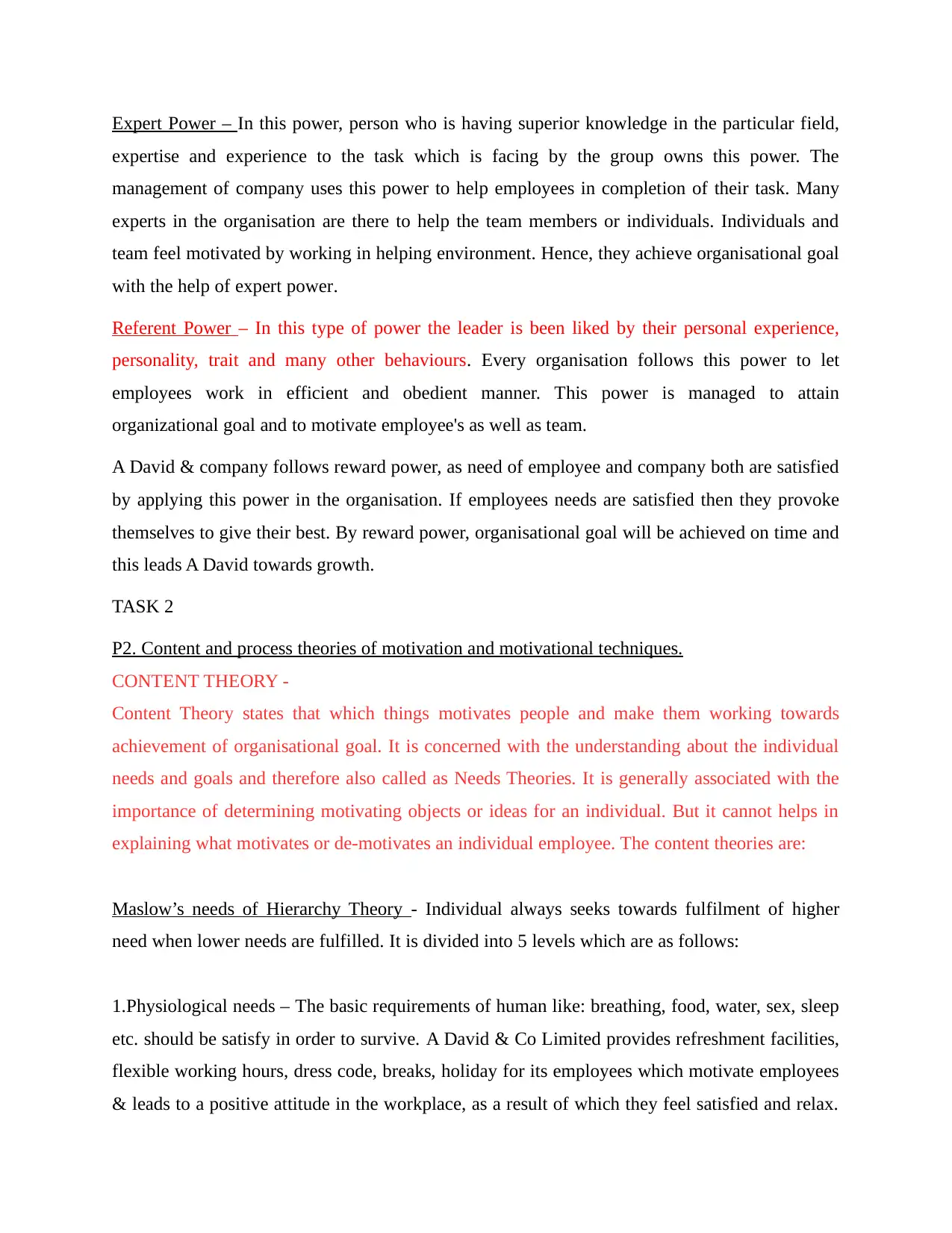
Expert Power – In this power, person who is having superior knowledge in the particular field,
expertise and experience to the task which is facing by the group owns this power. The
management of company uses this power to help employees in completion of their task. Many
experts in the organisation are there to help the team members or individuals. Individuals and
team feel motivated by working in helping environment. Hence, they achieve organisational goal
with the help of expert power.
Referent Power – In this type of power the leader is been liked by their personal experience,
personality, trait and many other behaviours. Every organisation follows this power to let
employees work in efficient and obedient manner. This power is managed to attain
organizational goal and to motivate employee's as well as team.
A David & company follows reward power, as need of employee and company both are satisfied
by applying this power in the organisation. If employees needs are satisfied then they provoke
themselves to give their best. By reward power, organisational goal will be achieved on time and
this leads A David towards growth.
TASK 2
P2. Content and process theories of motivation and motivational techniques.
CONTENT THEORY -
Content Theory states that which things motivates people and make them working towards
achievement of organisational goal. It is concerned with the understanding about the individual
needs and goals and therefore also called as Needs Theories. It is generally associated with the
importance of determining motivating objects or ideas for an individual. But it cannot helps in
explaining what motivates or de-motivates an individual employee. The content theories are:
Maslow’s needs of Hierarchy Theory - Individual always seeks towards fulfilment of higher
need when lower needs are fulfilled. It is divided into 5 levels which are as follows:
1.Physiological needs – The basic requirements of human like: breathing, food, water, sex, sleep
etc. should be satisfy in order to survive. A David & Co Limited provides refreshment facilities,
flexible working hours, dress code, breaks, holiday for its employees which motivate employees
& leads to a positive attitude in the workplace, as a result of which they feel satisfied and relax.
expertise and experience to the task which is facing by the group owns this power. The
management of company uses this power to help employees in completion of their task. Many
experts in the organisation are there to help the team members or individuals. Individuals and
team feel motivated by working in helping environment. Hence, they achieve organisational goal
with the help of expert power.
Referent Power – In this type of power the leader is been liked by their personal experience,
personality, trait and many other behaviours. Every organisation follows this power to let
employees work in efficient and obedient manner. This power is managed to attain
organizational goal and to motivate employee's as well as team.
A David & company follows reward power, as need of employee and company both are satisfied
by applying this power in the organisation. If employees needs are satisfied then they provoke
themselves to give their best. By reward power, organisational goal will be achieved on time and
this leads A David towards growth.
TASK 2
P2. Content and process theories of motivation and motivational techniques.
CONTENT THEORY -
Content Theory states that which things motivates people and make them working towards
achievement of organisational goal. It is concerned with the understanding about the individual
needs and goals and therefore also called as Needs Theories. It is generally associated with the
importance of determining motivating objects or ideas for an individual. But it cannot helps in
explaining what motivates or de-motivates an individual employee. The content theories are:
Maslow’s needs of Hierarchy Theory - Individual always seeks towards fulfilment of higher
need when lower needs are fulfilled. It is divided into 5 levels which are as follows:
1.Physiological needs – The basic requirements of human like: breathing, food, water, sex, sleep
etc. should be satisfy in order to survive. A David & Co Limited provides refreshment facilities,
flexible working hours, dress code, breaks, holiday for its employees which motivate employees
& leads to a positive attitude in the workplace, as a result of which they feel satisfied and relax.
Paraphrase This Document
Need a fresh take? Get an instant paraphrase of this document with our AI Paraphraser
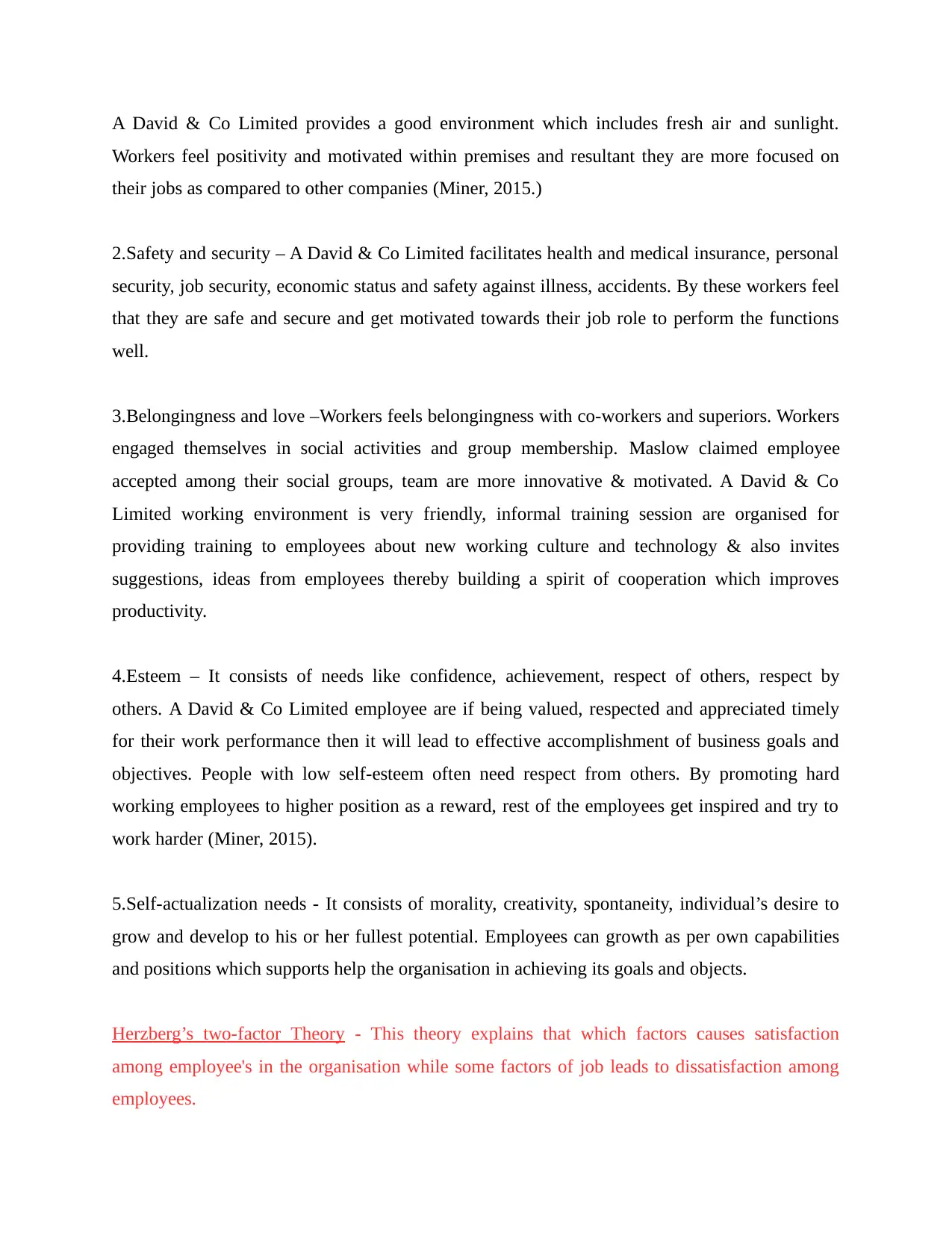
A David & Co Limited provides a good environment which includes fresh air and sunlight.
Workers feel positivity and motivated within premises and resultant they are more focused on
their jobs as compared to other companies (Miner, 2015.)
2.Safety and security – A David & Co Limited facilitates health and medical insurance, personal
security, job security, economic status and safety against illness, accidents. By these workers feel
that they are safe and secure and get motivated towards their job role to perform the functions
well.
3.Belongingness and love –Workers feels belongingness with co-workers and superiors. Workers
engaged themselves in social activities and group membership. Maslow claimed employee
accepted among their social groups, team are more innovative & motivated. A David & Co
Limited working environment is very friendly, informal training session are organised for
providing training to employees about new working culture and technology & also invites
suggestions, ideas from employees thereby building a spirit of cooperation which improves
productivity.
4.Esteem – It consists of needs like confidence, achievement, respect of others, respect by
others. A David & Co Limited employee are if being valued, respected and appreciated timely
for their work performance then it will lead to effective accomplishment of business goals and
objectives. People with low self-esteem often need respect from others. By promoting hard
working employees to higher position as a reward, rest of the employees get inspired and try to
work harder (Miner, 2015).
5.Self-actualization needs - It consists of morality, creativity, spontaneity, individual’s desire to
grow and develop to his or her fullest potential. Employees can growth as per own capabilities
and positions which supports help the organisation in achieving its goals and objects.
Herzberg’s two-factor Theory - This theory explains that which factors causes satisfaction
among employee's in the organisation while some factors of job leads to dissatisfaction among
employees.
Workers feel positivity and motivated within premises and resultant they are more focused on
their jobs as compared to other companies (Miner, 2015.)
2.Safety and security – A David & Co Limited facilitates health and medical insurance, personal
security, job security, economic status and safety against illness, accidents. By these workers feel
that they are safe and secure and get motivated towards their job role to perform the functions
well.
3.Belongingness and love –Workers feels belongingness with co-workers and superiors. Workers
engaged themselves in social activities and group membership. Maslow claimed employee
accepted among their social groups, team are more innovative & motivated. A David & Co
Limited working environment is very friendly, informal training session are organised for
providing training to employees about new working culture and technology & also invites
suggestions, ideas from employees thereby building a spirit of cooperation which improves
productivity.
4.Esteem – It consists of needs like confidence, achievement, respect of others, respect by
others. A David & Co Limited employee are if being valued, respected and appreciated timely
for their work performance then it will lead to effective accomplishment of business goals and
objectives. People with low self-esteem often need respect from others. By promoting hard
working employees to higher position as a reward, rest of the employees get inspired and try to
work harder (Miner, 2015).
5.Self-actualization needs - It consists of morality, creativity, spontaneity, individual’s desire to
grow and develop to his or her fullest potential. Employees can growth as per own capabilities
and positions which supports help the organisation in achieving its goals and objects.
Herzberg’s two-factor Theory - This theory explains that which factors causes satisfaction
among employee's in the organisation while some factors of job leads to dissatisfaction among
employees.
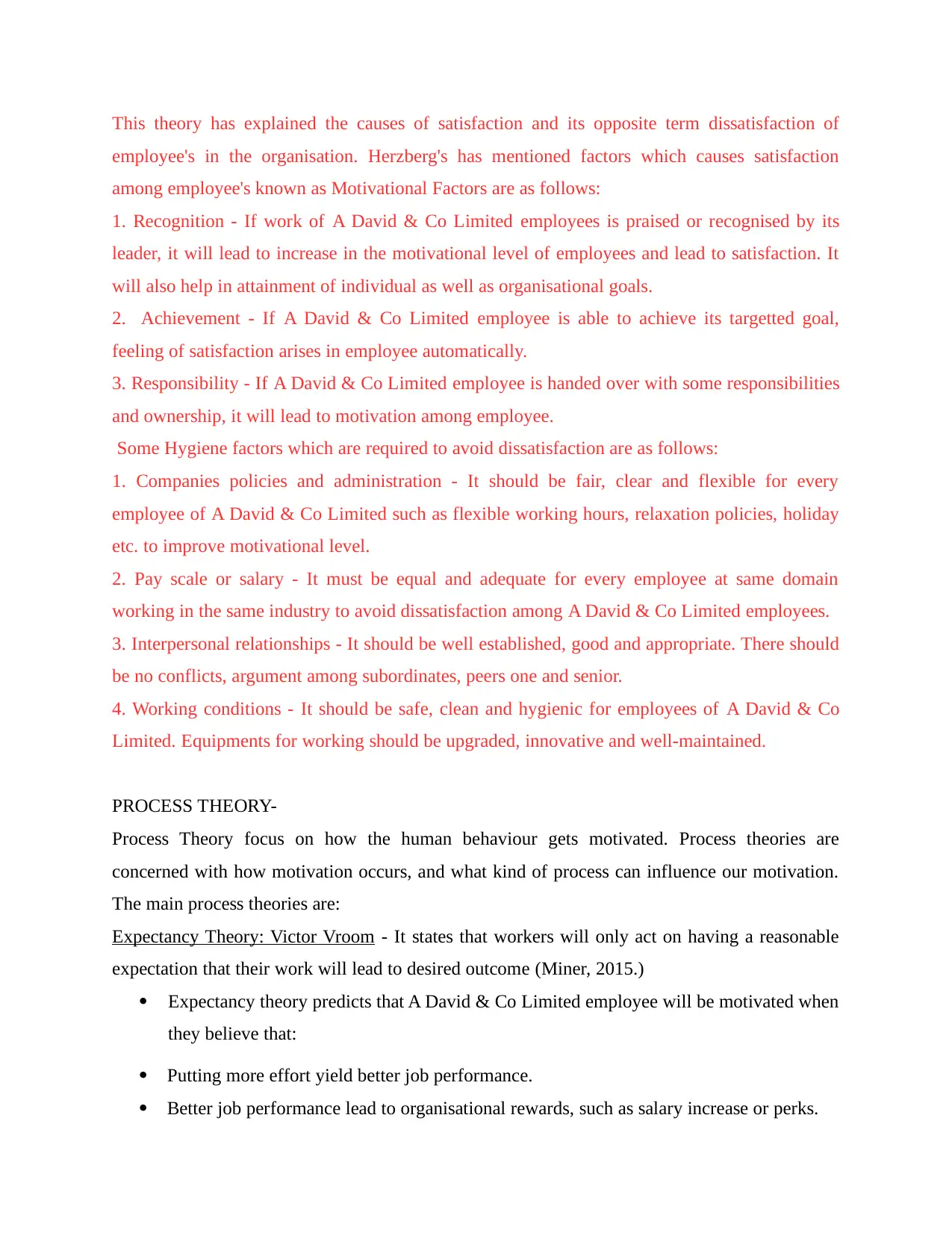
This theory has explained the causes of satisfaction and its opposite term dissatisfaction of
employee's in the organisation. Herzberg's has mentioned factors which causes satisfaction
among employee's known as Motivational Factors are as follows:
1. Recognition - If work of A David & Co Limited employees is praised or recognised by its
leader, it will lead to increase in the motivational level of employees and lead to satisfaction. It
will also help in attainment of individual as well as organisational goals.
2. Achievement - If A David & Co Limited employee is able to achieve its targetted goal,
feeling of satisfaction arises in employee automatically.
3. Responsibility - If A David & Co Limited employee is handed over with some responsibilities
and ownership, it will lead to motivation among employee.
Some Hygiene factors which are required to avoid dissatisfaction are as follows:
1. Companies policies and administration - It should be fair, clear and flexible for every
employee of A David & Co Limited such as flexible working hours, relaxation policies, holiday
etc. to improve motivational level.
2. Pay scale or salary - It must be equal and adequate for every employee at same domain
working in the same industry to avoid dissatisfaction among A David & Co Limited employees.
3. Interpersonal relationships - It should be well established, good and appropriate. There should
be no conflicts, argument among subordinates, peers one and senior.
4. Working conditions - It should be safe, clean and hygienic for employees of A David & Co
Limited. Equipments for working should be upgraded, innovative and well-maintained.
PROCESS THEORY-
Process Theory focus on how the human behaviour gets motivated. Process theories are
concerned with how motivation occurs, and what kind of process can influence our motivation.
The main process theories are:
Expectancy Theory: Victor Vroom - It states that workers will only act on having a reasonable
expectation that their work will lead to desired outcome (Miner, 2015.)
Expectancy theory predicts that A David & Co Limited employee will be motivated when
they believe that:
Putting more effort yield better job performance.
Better job performance lead to organisational rewards, such as salary increase or perks.
employee's in the organisation. Herzberg's has mentioned factors which causes satisfaction
among employee's known as Motivational Factors are as follows:
1. Recognition - If work of A David & Co Limited employees is praised or recognised by its
leader, it will lead to increase in the motivational level of employees and lead to satisfaction. It
will also help in attainment of individual as well as organisational goals.
2. Achievement - If A David & Co Limited employee is able to achieve its targetted goal,
feeling of satisfaction arises in employee automatically.
3. Responsibility - If A David & Co Limited employee is handed over with some responsibilities
and ownership, it will lead to motivation among employee.
Some Hygiene factors which are required to avoid dissatisfaction are as follows:
1. Companies policies and administration - It should be fair, clear and flexible for every
employee of A David & Co Limited such as flexible working hours, relaxation policies, holiday
etc. to improve motivational level.
2. Pay scale or salary - It must be equal and adequate for every employee at same domain
working in the same industry to avoid dissatisfaction among A David & Co Limited employees.
3. Interpersonal relationships - It should be well established, good and appropriate. There should
be no conflicts, argument among subordinates, peers one and senior.
4. Working conditions - It should be safe, clean and hygienic for employees of A David & Co
Limited. Equipments for working should be upgraded, innovative and well-maintained.
PROCESS THEORY-
Process Theory focus on how the human behaviour gets motivated. Process theories are
concerned with how motivation occurs, and what kind of process can influence our motivation.
The main process theories are:
Expectancy Theory: Victor Vroom - It states that workers will only act on having a reasonable
expectation that their work will lead to desired outcome (Miner, 2015.)
Expectancy theory predicts that A David & Co Limited employee will be motivated when
they believe that:
Putting more effort yield better job performance.
Better job performance lead to organisational rewards, such as salary increase or perks.
⊘ This is a preview!⊘
Do you want full access?
Subscribe today to unlock all pages.

Trusted by 1+ million students worldwide
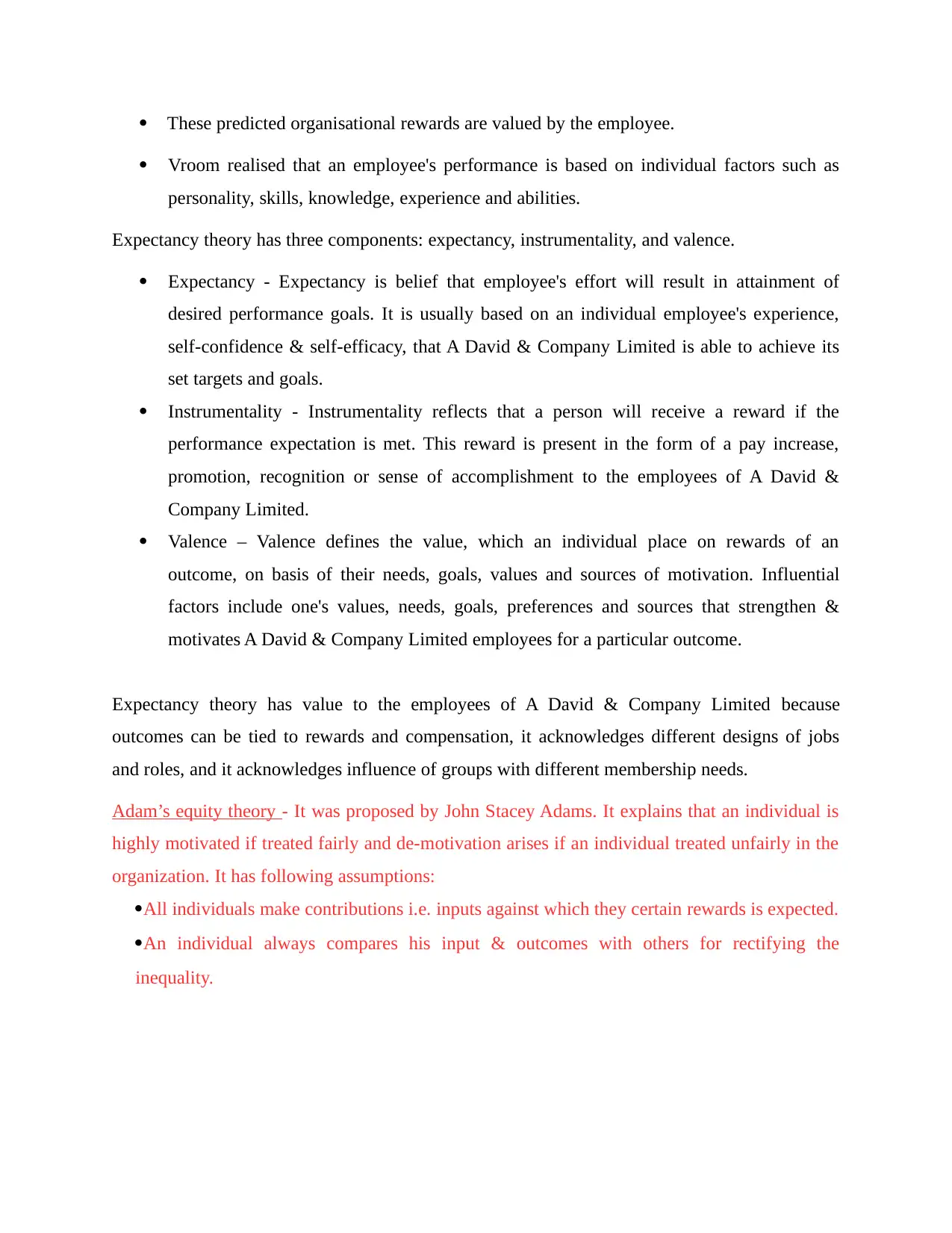
These predicted organisational rewards are valued by the employee.
Vroom realised that an employee's performance is based on individual factors such as
personality, skills, knowledge, experience and abilities.
Expectancy theory has three components: expectancy, instrumentality, and valence.
Expectancy - Expectancy is belief that employee's effort will result in attainment of
desired performance goals. It is usually based on an individual employee's experience,
self-confidence & self-efficacy, that A David & Company Limited is able to achieve its
set targets and goals.
Instrumentality - Instrumentality reflects that a person will receive a reward if the
performance expectation is met. This reward is present in the form of a pay increase,
promotion, recognition or sense of accomplishment to the employees of A David &
Company Limited.
Valence – Valence defines the value, which an individual place on rewards of an
outcome, on basis of their needs, goals, values and sources of motivation. Influential
factors include one's values, needs, goals, preferences and sources that strengthen &
motivates A David & Company Limited employees for a particular outcome.
Expectancy theory has value to the employees of A David & Company Limited because
outcomes can be tied to rewards and compensation, it acknowledges different designs of jobs
and roles, and it acknowledges influence of groups with different membership needs.
Adam’s equity theory - It was proposed by John Stacey Adams. It explains that an individual is
highly motivated if treated fairly and de-motivation arises if an individual treated unfairly in the
organization. It has following assumptions:
All individuals make contributions i.e. inputs against which they certain rewards is expected.
An individual always compares his input & outcomes with others for rectifying the
inequality.
Vroom realised that an employee's performance is based on individual factors such as
personality, skills, knowledge, experience and abilities.
Expectancy theory has three components: expectancy, instrumentality, and valence.
Expectancy - Expectancy is belief that employee's effort will result in attainment of
desired performance goals. It is usually based on an individual employee's experience,
self-confidence & self-efficacy, that A David & Company Limited is able to achieve its
set targets and goals.
Instrumentality - Instrumentality reflects that a person will receive a reward if the
performance expectation is met. This reward is present in the form of a pay increase,
promotion, recognition or sense of accomplishment to the employees of A David &
Company Limited.
Valence – Valence defines the value, which an individual place on rewards of an
outcome, on basis of their needs, goals, values and sources of motivation. Influential
factors include one's values, needs, goals, preferences and sources that strengthen &
motivates A David & Company Limited employees for a particular outcome.
Expectancy theory has value to the employees of A David & Company Limited because
outcomes can be tied to rewards and compensation, it acknowledges different designs of jobs
and roles, and it acknowledges influence of groups with different membership needs.
Adam’s equity theory - It was proposed by John Stacey Adams. It explains that an individual is
highly motivated if treated fairly and de-motivation arises if an individual treated unfairly in the
organization. It has following assumptions:
All individuals make contributions i.e. inputs against which they certain rewards is expected.
An individual always compares his input & outcomes with others for rectifying the
inequality.
Paraphrase This Document
Need a fresh take? Get an instant paraphrase of this document with our AI Paraphraser
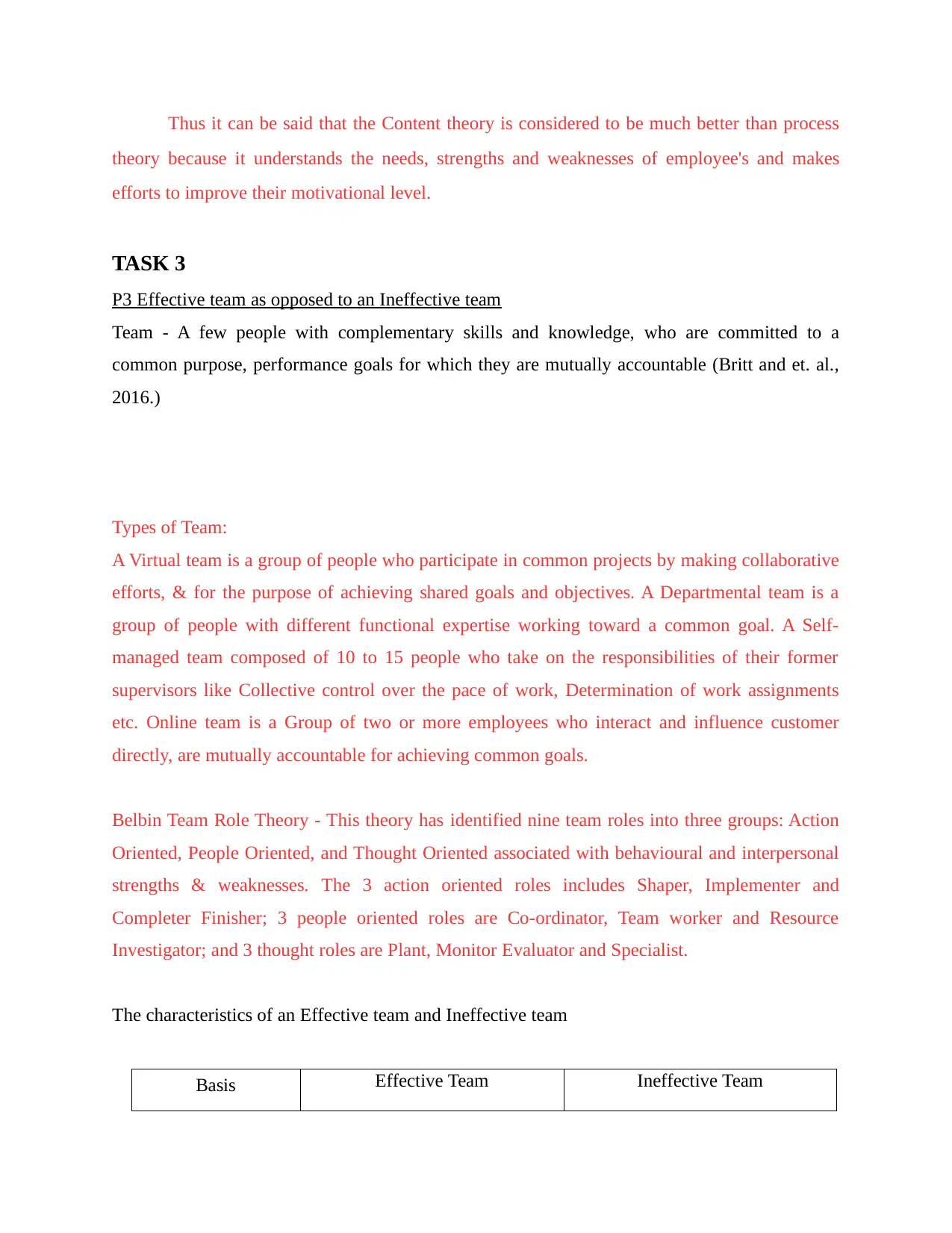
Thus it can be said that the Content theory is considered to be much better than process
theory because it understands the needs, strengths and weaknesses of employee's and makes
efforts to improve their motivational level.
TASK 3
P3 Effective team as opposed to an Ineffective team
Team - A few people with complementary skills and knowledge, who are committed to a
common purpose, performance goals for which they are mutually accountable (Britt and et. al.,
2016.)
Types of Team:
A Virtual team is a group of people who participate in common projects by making collaborative
efforts, & for the purpose of achieving shared goals and objectives. A Departmental team is a
group of people with different functional expertise working toward a common goal. A Self-
managed team composed of 10 to 15 people who take on the responsibilities of their former
supervisors like Collective control over the pace of work, Determination of work assignments
etc. Online team is a Group of two or more employees who interact and influence customer
directly, are mutually accountable for achieving common goals.
Belbin Team Role Theory - This theory has identified nine team roles into three groups: Action
Oriented, People Oriented, and Thought Oriented associated with behavioural and interpersonal
strengths & weaknesses. The 3 action oriented roles includes Shaper, Implementer and
Completer Finisher; 3 people oriented roles are Co-ordinator, Team worker and Resource
Investigator; and 3 thought roles are Plant, Monitor Evaluator and Specialist.
The characteristics of an Effective team and Ineffective team
Basis Effective Team Ineffective Team
theory because it understands the needs, strengths and weaknesses of employee's and makes
efforts to improve their motivational level.
TASK 3
P3 Effective team as opposed to an Ineffective team
Team - A few people with complementary skills and knowledge, who are committed to a
common purpose, performance goals for which they are mutually accountable (Britt and et. al.,
2016.)
Types of Team:
A Virtual team is a group of people who participate in common projects by making collaborative
efforts, & for the purpose of achieving shared goals and objectives. A Departmental team is a
group of people with different functional expertise working toward a common goal. A Self-
managed team composed of 10 to 15 people who take on the responsibilities of their former
supervisors like Collective control over the pace of work, Determination of work assignments
etc. Online team is a Group of two or more employees who interact and influence customer
directly, are mutually accountable for achieving common goals.
Belbin Team Role Theory - This theory has identified nine team roles into three groups: Action
Oriented, People Oriented, and Thought Oriented associated with behavioural and interpersonal
strengths & weaknesses. The 3 action oriented roles includes Shaper, Implementer and
Completer Finisher; 3 people oriented roles are Co-ordinator, Team worker and Resource
Investigator; and 3 thought roles are Plant, Monitor Evaluator and Specialist.
The characteristics of an Effective team and Ineffective team
Basis Effective Team Ineffective Team
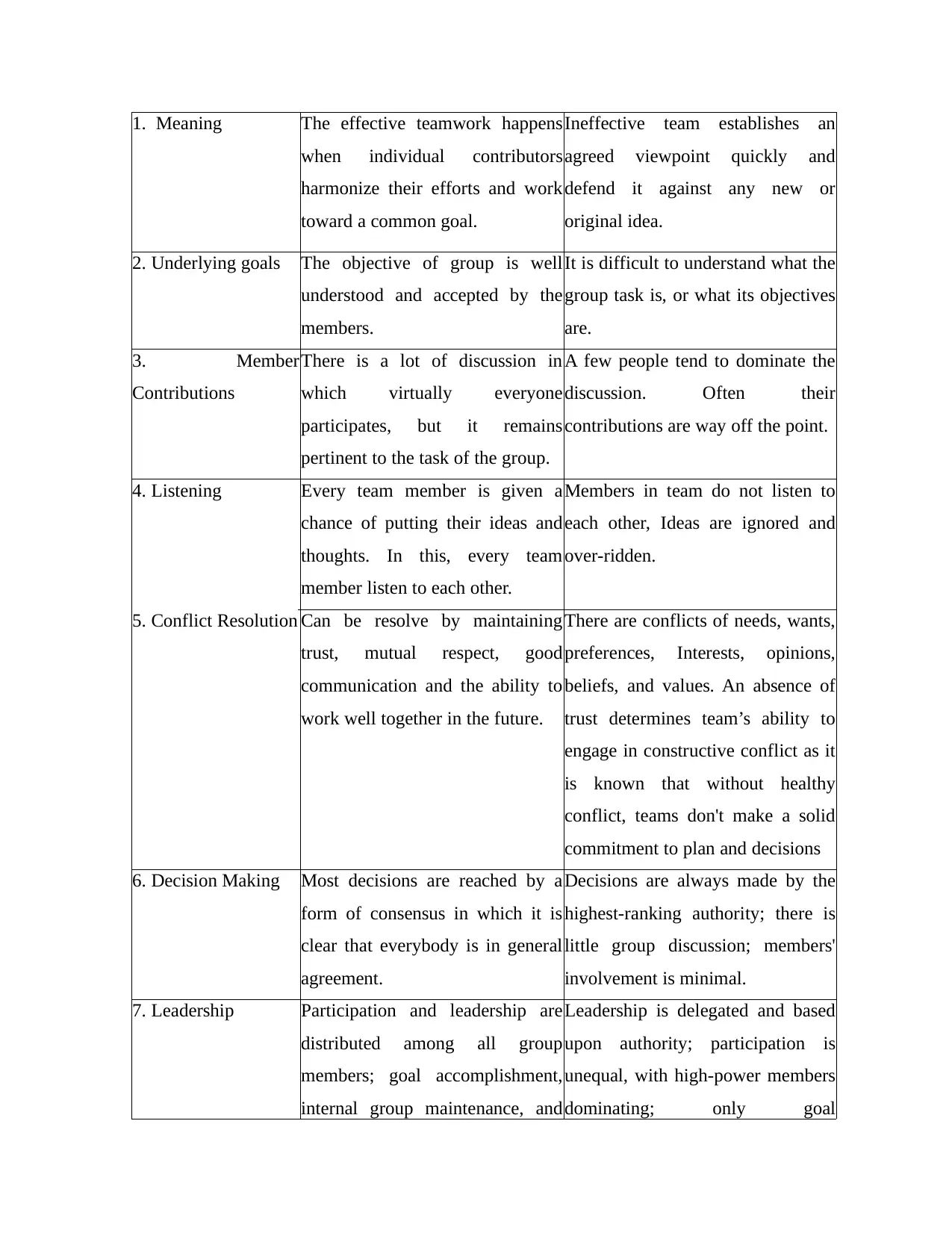
1. Meaning The effective teamwork happens
when individual contributors
harmonize their efforts and work
toward a common goal.
Ineffective team establishes an
agreed viewpoint quickly and
defend it against any new or
original idea.
2. Underlying goals The objective of group is well
understood and accepted by the
members.
It is difficult to understand what the
group task is, or what its objectives
are.
3. Member
Contributions
There is a lot of discussion in
which virtually everyone
participates, but it remains
pertinent to the task of the group.
A few people tend to dominate the
discussion. Often their
contributions are way off the point.
4. Listening Every team member is given a
chance of putting their ideas and
thoughts. In this, every team
member listen to each other.
Members in team do not listen to
each other, Ideas are ignored and
over-ridden.
5. Conflict Resolution Can be resolve by maintaining
trust, mutual respect, good
communication and the ability to
work well together in the future.
There are conflicts of needs, wants,
preferences, Interests, opinions,
beliefs, and values. An absence of
trust determines team’s ability to
engage in constructive conflict as it
is known that without healthy
conflict, teams don't make a solid
commitment to plan and decisions
6. Decision Making Most decisions are reached by a
form of consensus in which it is
clear that everybody is in general
agreement.
Decisions are always made by the
highest-ranking authority; there is
little group discussion; members'
involvement is minimal.
7. Leadership Participation and leadership are
distributed among all group
members; goal accomplishment,
internal group maintenance, and
Leadership is delegated and based
upon authority; participation is
unequal, with high-power members
dominating; only goal
when individual contributors
harmonize their efforts and work
toward a common goal.
Ineffective team establishes an
agreed viewpoint quickly and
defend it against any new or
original idea.
2. Underlying goals The objective of group is well
understood and accepted by the
members.
It is difficult to understand what the
group task is, or what its objectives
are.
3. Member
Contributions
There is a lot of discussion in
which virtually everyone
participates, but it remains
pertinent to the task of the group.
A few people tend to dominate the
discussion. Often their
contributions are way off the point.
4. Listening Every team member is given a
chance of putting their ideas and
thoughts. In this, every team
member listen to each other.
Members in team do not listen to
each other, Ideas are ignored and
over-ridden.
5. Conflict Resolution Can be resolve by maintaining
trust, mutual respect, good
communication and the ability to
work well together in the future.
There are conflicts of needs, wants,
preferences, Interests, opinions,
beliefs, and values. An absence of
trust determines team’s ability to
engage in constructive conflict as it
is known that without healthy
conflict, teams don't make a solid
commitment to plan and decisions
6. Decision Making Most decisions are reached by a
form of consensus in which it is
clear that everybody is in general
agreement.
Decisions are always made by the
highest-ranking authority; there is
little group discussion; members'
involvement is minimal.
7. Leadership Participation and leadership are
distributed among all group
members; goal accomplishment,
internal group maintenance, and
Leadership is delegated and based
upon authority; participation is
unequal, with high-power members
dominating; only goal
⊘ This is a preview!⊘
Do you want full access?
Subscribe today to unlock all pages.

Trusted by 1+ million students worldwide
1 out of 18
Related Documents
Your All-in-One AI-Powered Toolkit for Academic Success.
+13062052269
info@desklib.com
Available 24*7 on WhatsApp / Email
![[object Object]](/_next/static/media/star-bottom.7253800d.svg)
Unlock your academic potential
Copyright © 2020–2025 A2Z Services. All Rights Reserved. Developed and managed by ZUCOL.





